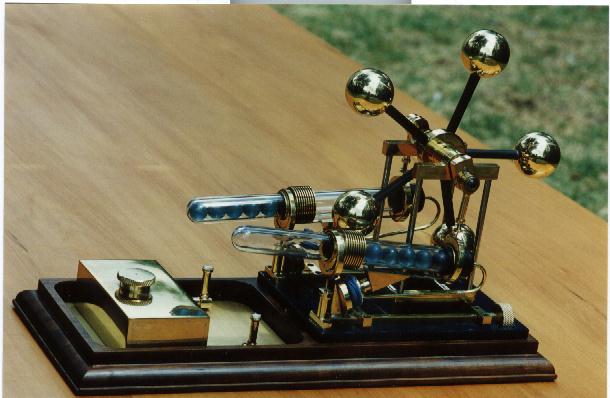mklotz
Well-Known Member
I had a dashpot lying around and decided it would make a perfect piston-cylinder for an LTD (Low Temperature Differential) Stirling engine. I wanted to build a Ringbom engine but, in a personal communication with Dr. James Senft, the guru of all LTD Stirling, I was advised that it was a tricky proposition and would only run in a very narrow temperature range if, indeed, it ran at all.
Despite this good advice, I cobbled together a Ringbom using proportions that 'looked right to me'. Well, the good Doctor was right and it didn't want to run - a fact that didn't surprise me given the (non)effort I had expended in its design.
Then, while fooling around with it, I decided that it didn't run because I made the displacer a tad bit heavy and it couldn't generate enough gas pressure to lift it if run in the position pictured below. So, no worry - I turned it on its side (flywheel horizontal and displacer chamber vertical), heated it gently with a small alcohol lamp, and it took off very nicely.
Ringboms will run with the flywheel rotating in either direction and this one does that, making a tiny tump-tump sound as the displacer is driven in and out by the changing gas pressure. Their utter mechanical simplicity is mesmerizing.

Note that the flywheel is made from a Microsoft software CD. This is the first occasion in recorded history where Microsoft software has done something reliably - even if it's just going in circles. Even the bloat of MS wasn't sufficient, though, and I had to add some pocket change to the disk to get enough inertia.

Don't ask me for plans for this engine. There aren't any because I built it from a mental image I had and, no, I won't take it apart and draw plans from the pieces.
Despite this good advice, I cobbled together a Ringbom using proportions that 'looked right to me'. Well, the good Doctor was right and it didn't want to run - a fact that didn't surprise me given the (non)effort I had expended in its design.
Then, while fooling around with it, I decided that it didn't run because I made the displacer a tad bit heavy and it couldn't generate enough gas pressure to lift it if run in the position pictured below. So, no worry - I turned it on its side (flywheel horizontal and displacer chamber vertical), heated it gently with a small alcohol lamp, and it took off very nicely.
Ringboms will run with the flywheel rotating in either direction and this one does that, making a tiny tump-tump sound as the displacer is driven in and out by the changing gas pressure. Their utter mechanical simplicity is mesmerizing.

Note that the flywheel is made from a Microsoft software CD. This is the first occasion in recorded history where Microsoft software has done something reliably - even if it's just going in circles. Even the bloat of MS wasn't sufficient, though, and I had to add some pocket change to the disk to get enough inertia.

Don't ask me for plans for this engine. There aren't any because I built it from a mental image I had and, no, I won't take it apart and draw plans from the pieces.









